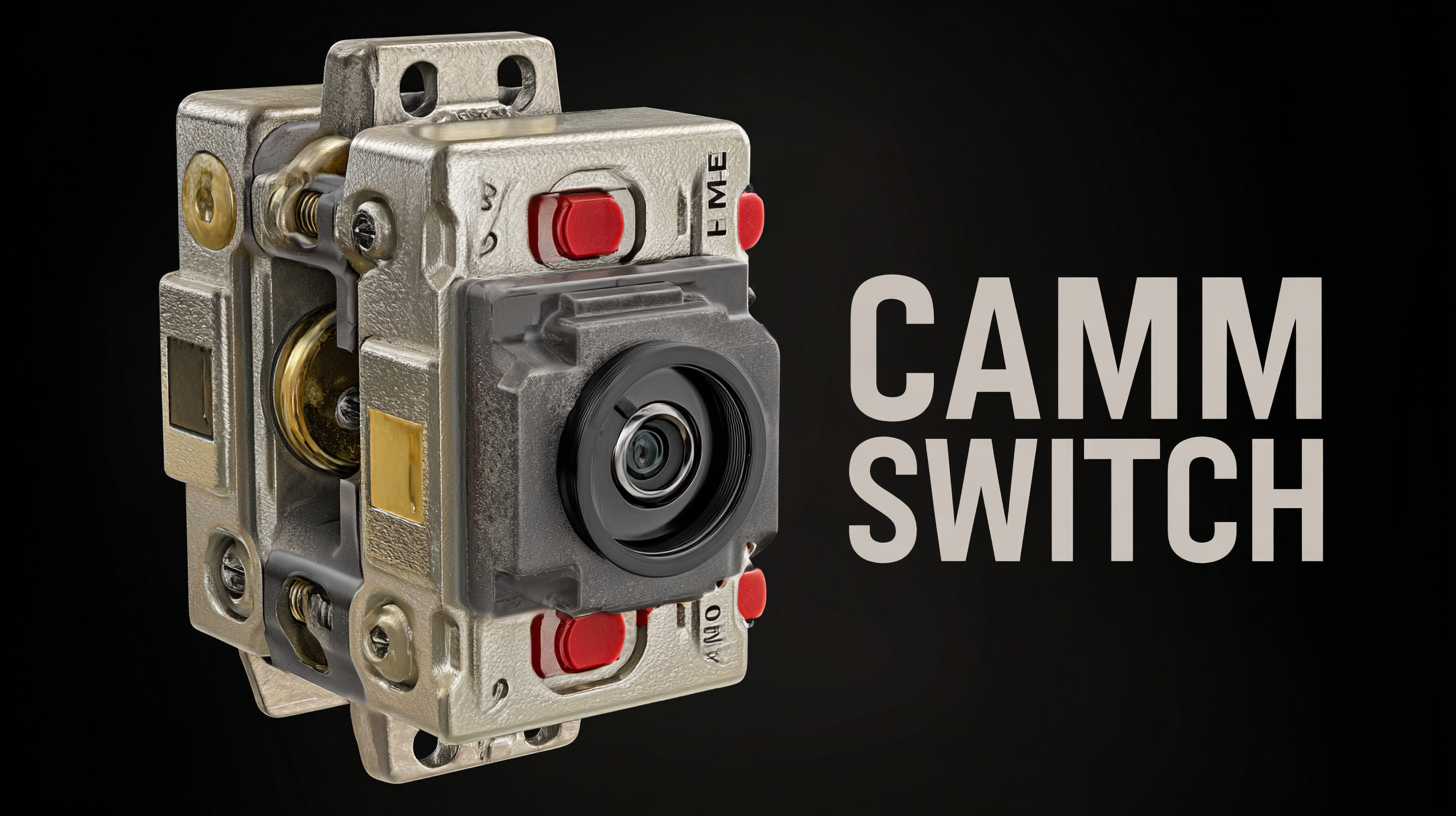
Ultimate Guide to Choosing the Best Cam Switch for Your Industrial Needs
In the ever-evolving landscape of industrial automation, selecting the right components can significantly impact operational efficiency and safety. Among these critical components, cam switches emerge as key players due to their versatility and reliability. According to a recent market research report by MarketsandMarkets, the global industrial switches market is projected to reach $10.6 billion by 2025, driven by advancements in automation and the rising demand for compact and efficient control devices. Cam switches, known for their durable construction and ability to manage various electrical loads, are becoming increasingly popular in diverse applications, from manufacturing to power generation. This ultimate guide will delve into the essential factors to consider when choosing the best cam switch for your industrial needs, ensuring that you make informed decisions that enhance productivity and safety in your operations.

Understanding Cam Switches: Key Features and Benefits for Industrial Applications
In industrial applications, cam switches play a pivotal role in controlling electrical circuits and ensuring operational efficiency. Understanding their key features is essential when selecting the right switch for specific industrial needs. For instance, the durability of cam switches is critical; they are designed to withstand extreme conditions and frequent operations, making them suitable for heavy-duty tasks. Reports indicate that the global cam switch market is projected to grow at a CAGR of over 5% from 2023 to 2030 due to the rising demand for automated machinery and advanced electrical systems.
Moreover, the benefits of using cam switches extend beyond mere functionality. Their compact design allows for space-saving installations, which is a significant advantage in modern industrial settings where equipment footprint is a concern. The versatile application of these switches in various sectors, including manufacturing and energy, ensures that they meet diverse operational requirements. Additionally, the integration of smart technology into cam switches facilitates seamless connectivity and real-time monitoring, positioning them as a vital component in the ongoing transition toward more connected industrial environments. This adaptability underscores the importance of selecting a cam switch that aligns not just with current needs but also future technological advancements.
Ultimate Guide to Choosing the Best Cam Switch for Your Industrial Needs
| Feature | Description | Benefit |
|---|---|---|
| Durability | Made from robust materials to withstand harsh conditions. | Longer lifespan in industrial environments. |
| Switching Capability | Can handle multiple circuits and configurations. | Flexibility in controlling various components. |
| Ease of Use | User-friendly design with ergonomic handles. | Simplified operation for quick adjustments. |
| Safety Features | Incorporates safety interlocks and protective covers. | Reduces risk of accidents and electrical hazards. |
| Customizability | Available in various configurations to meet specific needs. | Tailored solutions for different applications. |
| Compliance | Meets international standards and regulations. | Ensures reliability and quality assurance. |
Identifying the Right Cam Switch Type for Your Specific Operational Needs
When it comes to selecting the right cam switch for your industrial applications, understanding the specific operational needs is crucial. Cam switches come in various types, each designed to cater to different functions and environments. For instance, if your operation requires frequent on-off switching, a switch with a robust design and durable materials is essential to withstand the demands of high usage. Similarly, for applications involving heavy machinery, choosing a heavy-duty cam switch can enhance reliability and safety.
Another factor to consider is the electrical specifications required for your operations. Assess the voltage and current ratings your application demands, as these will dictate the compatibility of the cam switch with your system. Additionally, think about environmental factors such as moisture, dust, and temperature variations; switches rated for harsh conditions will not only ensure longevity but also optimal performance. By identifying these specific needs, you can make a well-informed decision that aligns with your operational requirements, ensuring seamless and efficient performance in your industrial processes.
Factors to Consider When Selecting a Cam Switch: Durability, Ratings, and Compatibility
When selecting a cam switch for industrial applications, durability is paramount. Industrial environments often expose components to harsh conditions, including temperature fluctuations, moisture, and mechanical wear. Choosing a switch made from robust materials, such as high-strength plastics or metals, can significantly enhance its lifespan and reliability. Additionally, look for switches with protective enclosures to shield against dust and water, which are common in many industrial settings.
Ratings are another critical factor to consider. A cam switch must match the electrical requirements of the application, including voltage and current ratings. Overrating or underrating can lead to malfunctions or even dangerous situations. Always check the switch’s specifications to ensure it can handle the load and operating conditions expected in your environment. Furthermore, consider the switch's IP (Ingress Protection) rating, which indicates its resistance to dust and water ingress.
Compatibility cannot be overlooked. Ensure that the cam switch integrates seamlessly with your existing systems and components. Check for compatibility with various mounting options, connection types, and the overall design of your control panel. A well-matched cam switch will not only function more efficiently but also reduce installation time and maintenance costs in the long run.
Cam Switch Selection Factors
Top Brands and Models of Cam Switches: A Comparative Overview for Industrial Professionals
When it comes to selecting the best cam switches for industrial applications, understanding the
top brands and
models available is essential for professionals in the field.
Notably, the market is filled with various options catering to different functionalities and reliability standards.
Leading brands consistently offer durable switches with advanced features tailored for industrial environments,
ensuring that they meet stringent safety and performance requirements.
One key factor to consider while choosing a cam switch is the
rated current capacity. Switches with a higher current rating are generally
more resistant to wear and can handle heavy-duty applications. Additionally, look for models that provide multiple
positions and configurations, enabling greater flexibility in operation.
Tips:
1. Always check the IP rating
of the switch to ensure it is suitable for specific environmental conditions such as dust and moisture.
2. Compare warranty periods across various brands, as this can provide insights
into the manufacturer's confidence in their products.
3. Consider user reviews and industry ratings to gauge the reliability
of a specific model before making a purchase decision.

Maintenance and Troubleshooting Tips for Long-lasting Cam Switch Performance
When it comes to ensuring the longevity and efficiency of your cam switch, regular maintenance is key. One essential tip is to keep the switch clean and free of dust and debris. Over time, dirt can accumulate, potentially causing the contacts to fail or operate inefficiently. A simple routine of wiping down the exterior and using compressed air to clear out any particles can go a long way in maintaining optimal performance.
In addition to cleanliness, it's important to routinely check for any signs of wear or damage. Inspect the switch for any loose connections, burnt contacts, or corrosion. Addressing these issues early can prevent more significant failures down the line. For instance, replacing worn components or tightening loose connections can significantly extend the switch's lifespan and ensure reliable operation.
Lastly, consider implementing a periodic testing schedule to evaluate the performance of your cam switch. This may involve functionality tests or monitoring the electrical load to detect anomalies. By establishing this proactive approach, you can identify potential problems before they escalate, ultimately saving time and resources while maintaining consistent operation in your industrial environment.

